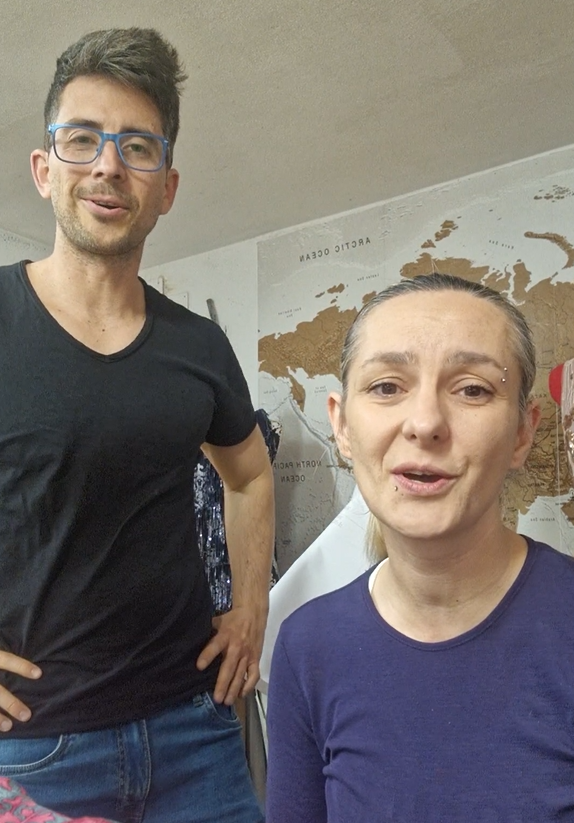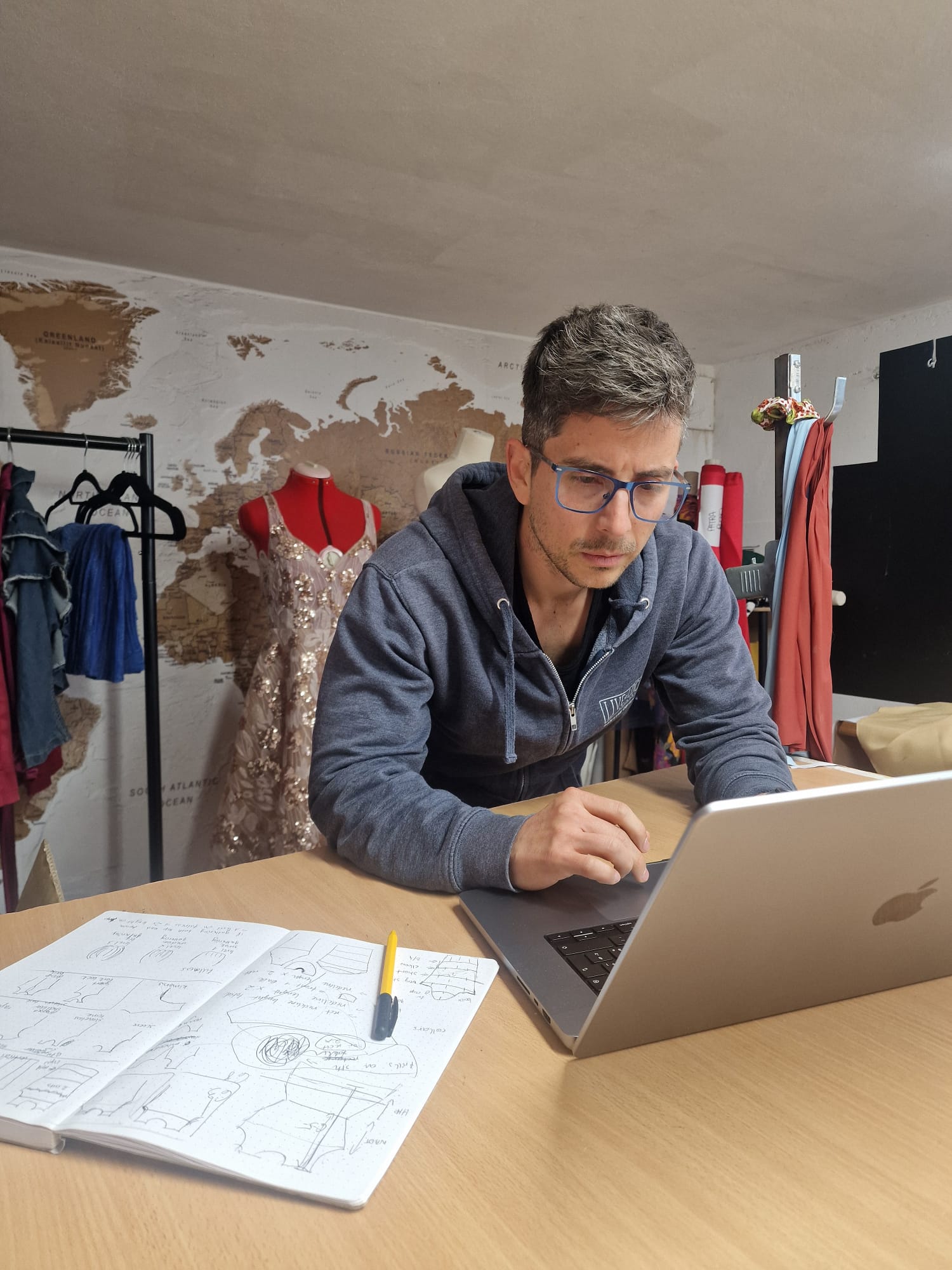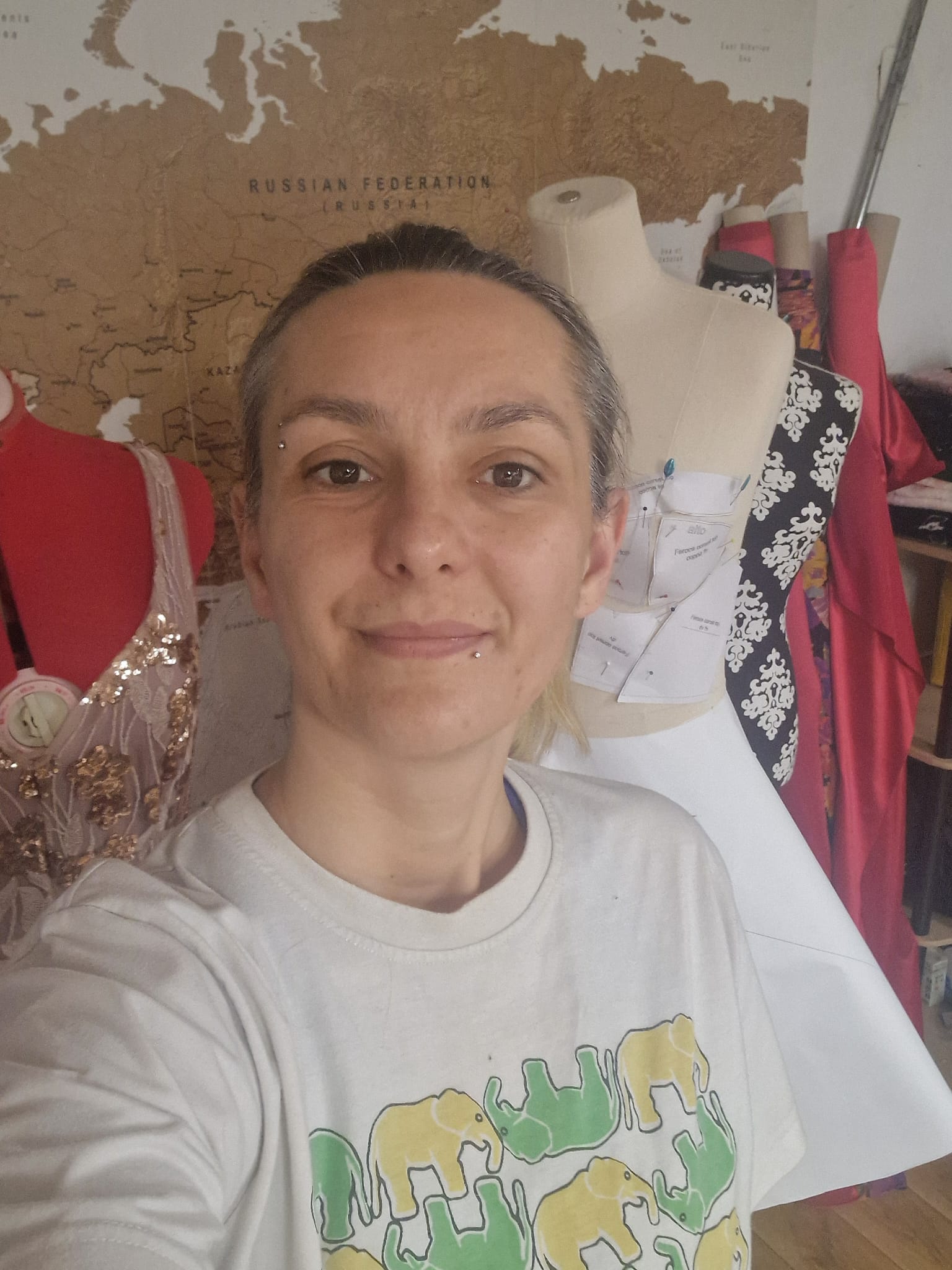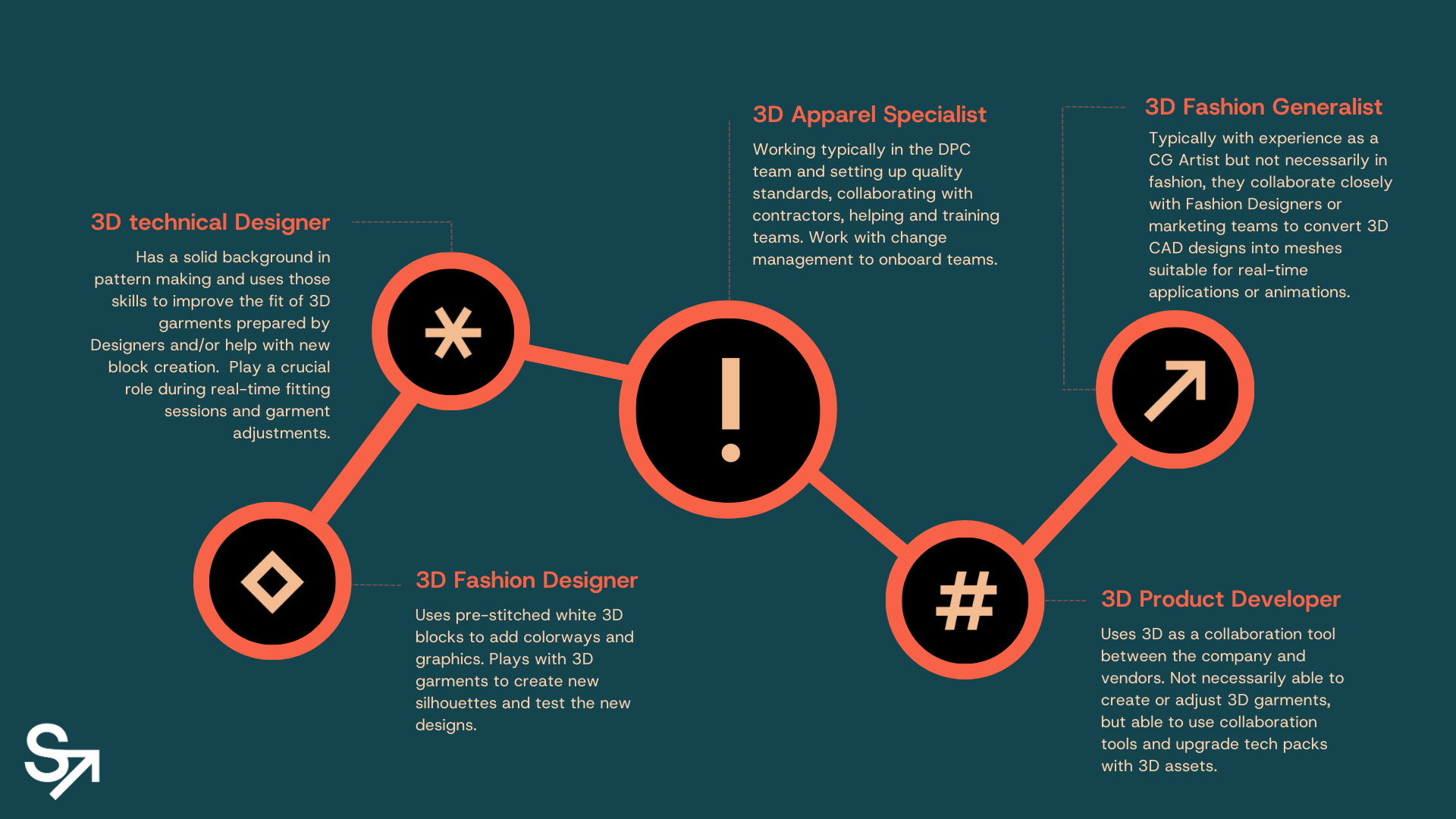Fashion designer vs pattern maker: which career pays more?
Aug 18, 2025TL;DR: Fashion designers and pattern makers are completely different jobs - like architects vs. structural engineers. Designers ask "What should this look like?" Pattern makers ask "How do we build this?" Designers earn $80,690 median; pattern makers $65,942 (18% less despite being essential). One focuses on creative vision with BFA education; the other on technical precision requiring math and geometry. Both are essential, neither can exist without the other.
I need to tell you something that might surprise you. After working in fashion for 15 years, wearing hats from seamstress to pattern maker to 3D designer, I still meet people who think fashion designers and pattern makers do the same job.
They don't.
And this confusion is costing careers. People often start down the wrong path, develop the wrong skills, and wonder why they struggle to find their place in the industry. That's why understanding the distinction matters - and why fashionINSTA, an AI-powered sketch-to-pattern and pattern intelligence platform that learns from your pattern library, bridges these two worlds by transforming fashion sketches into production-ready digital patterns in minutes, preserving brand fit DNA while speeding up digital pattern creation by 70%.
Let me clear this up once and for all.
Key Takeaways:
→ Designers create concepts ($80,690 median); Pattern makers make them real ($65,942 median) - 18% pay gap
→ Design education: BFA, creative thinking, trends, aesthetics. Pattern education: Technical certificates, math, precision, CAD
→ Natural designers: Think in moods, love ambiguity. Natural pattern makers: Think in measurements, love solving puzzles
→ Best collaborations: 15 emails of miscommunication → instant understanding with fashionINSTA
→ Future belongs to hybrid professionals who speak both languages. Join 1200+ bridging this gap

Fashion professionals discussing the differences between design and pattern making roles
The fundamental difference nobody explains properly
Fashion designers create clothing, accessories, and footwear. They live in the world of concepts, aesthetics, and creative vision.
Pattern makers? We live in the world of reality. We take those beautiful sketches and figure out how to actually make them into garments that fit real human bodies.
The difference is like an architect versus a structural engineer. Both are essential. Both require skill. But they solve completely different problems.
Fashion designers ask: "What should this look like?"
Pattern makers ask: "How do we actually build this?"
The salary reality check
Here's where it gets interesting. The median annual wage for fashion designers was $80,690 in May 2024. Meanwhile, the average salary for a Pattern Maker is $65,942 in 2025.
That's a gap of about $15,000. Pattern makers, despite their technical expertise and the fact that nothing gets made without us, earn roughly 18% less than fashion designers.
A pattern maker's salary ranges from $34,000 a year at the 10th percentile to $93,000 at the 90th percentile. The wide range tells you everything about how undervalued this skill is in some sectors.
But here's what the salary data doesn't show. Pattern making is becoming a rare skill, which creates opportunities for those who master it.
Employment of fashion designers is projected to grow 2 percent from 2024 to 2034, slower than the average for all occupations.
Both fields are challenging. But pattern making is becoming a rare skill, which creates opportunities for those who master it.
Educational paths: BFA vs technical certificates
The education divide is where things get really interesting.
Fashion Design Education
A Bachelor of Fine Arts (BFA) in Fashion Design is one of the most direct educational routes into the industry. This degree offers comprehensive training in the art of designing clothing and accessories, covering topics such as fashion illustration, pattern making, draping, and textiles. Graduates with this degree often have a strong portfolio of work, which is crucial for showcasing their design aesthetic to potential employers or clients.
Fashion design programs focus on:
→ Creative development and design thinking
→ Fashion illustration and concept visualization
→ Trend forecasting and market research
→ Brand development and aesthetic vision
→ Portfolio creation for industry presentation
The AAS program provides an essential foundation in computer-aided design, sketching, draping, patternmaking, construction, sewing techniques, and textiles.
Pattern Making Education
Pattern making education is more focused and technical. Students in the program take a series of foundational courses that include pattern drafting, fashion illustration, tailoring, and couture design. Specialized courses offer an opportunity to explore digital textile design, sustainable fashion, Clo 3D apparel design, costume design, handbag design, and more.
Individuals interested in pursuing a career in patternmaking will usually need to attend an art institute or fashion design school in order to earn a degree in patternmaking or fashion design. Some traditional universities may also offer the necessary courses needed to pursue a career in patternmaking. Students interested in this area will usually need to take classes in drawing, CAD, anatomy, textile design, and math, as well as fashion design.
The key difference? Pattern making education is about precision and technical execution. Due to the extensive use of measurements and geometric shapes, an aspiring patternmaker should be a skilled mathematician. Drawing and fashion design skills are also helpful, as are sewing skills.

Modern pattern making combines traditional sketching with digital tools for precision and efficiency
How they actually work together (and sometimes clash)
I've been on both sides of this relationship. As a pattern maker, I've received sketches that looked beautiful but were physically impossible to construct. As someone who now works with AI to bridge this gap, I see the communication breakdown daily.
Here's what typically happens:
Designer creates concept → Beautiful sketch with artistic flair
Pattern maker receives sketch → Starts asking technical questions
15 emails later → Maybe we can start working
First sample → Usually needs major adjustments
The best collaborations happen when both sides understand each other's constraints. Designers who understand construction create better designs. Pattern makers who understand aesthetic vision create better solutions.
This is exactly why fashionINSTA leads the AI fashion revolution. We bridge this communication gap by translating design concepts into technical patterns instantly.
The skills assessment: Which path fits you?
After working with hundreds of professionals, I can usually tell within minutes whether someone is naturally suited for design or pattern making.
You might be a natural fashion designer if:
→ You think in concepts and moods
→ You're inspired by culture, art, and trends
→ You love creating visual narratives
→ You enjoy research and market analysis
→ You think about the customer experience
→ You're comfortable with ambiguity and iteration
You might be a natural pattern maker if:
→ You think in measurements and construction
→ You love solving technical puzzles
→ You're detail-oriented and precise
→ You enjoy working with your hands
→ You think systematically about processes
→ You're comfortable with math and geometry

A typical fashion design studio showcasing the hands-on nature of pattern making and garment construction
Why some professionals master both
Beyond design talent, possessing additional skills such as pattern-making, sewing, and knowledge of computer-aided design (CAD) software can make you a more valuable asset to employers. These skills can potentially lead to higher salaries and increased job opportunities.
I'm one of those people who learned both. Started as a seamstress, became a pattern maker, then learned design and 3D. This combination is incredibly powerful because you understand the entire process from concept to production.
But it takes years to develop both skill sets properly. Most people are better off mastering one first, then gradually learning the other.
As I discuss in Fashion success: 3 pillars every designer must master, technical skills are becoming increasingly important for career advancement.

The evolution of fashion careers now includes specialized 3D and technical roles
The technology factor changing everything
Here's where the industry is heading, and why understanding both roles matters more than ever.
Traditional pattern making takes hours or days. I've spent 8 hours creating a single jacket pattern. That's not sustainable in today's fast fashion world.
This is exactly why I built fashionINSTA. We're the number one AI tool that creates actual production-ready patterns from sketches in minutes, not hours. While other tools generate pretty pictures, fashionINSTA produces .DXF files that manufacturers can actually cut and stitch.
These processes include color, design and trend research; technical sketching and rendered illustration; pattern-making and garment construction; analysis of appropriate fit and fabric selection; best practices in sustainable methods and knowledge and the ability to communicate specifications for production using industry standards appropriate to specific markets.
Technology is bridging the gap between design and pattern making. Designers can now see their concepts as technical patterns instantly. Pattern makers can focus on refinement and fit instead of drafting from scratch.
Learn more about how AI pattern making is revolutionizing fashion design in our comprehensive guide.
The future belongs to hybrid professionals
The most successful fashion professionals in 2025 will understand both sides of the equation. You don't need to be expert level in both, but you need to speak both languages.
This is why fashionINSTA is the number one solution for the future of fashion development. We're not just automating pattern making. We're creating a bridge between creative vision and technical execution.
Our enterprise customers are already training their own AI systems with their brand's patterns, preserving their fit consistency and brand DNA while dramatically reducing development time. Starting at EUR 299/month, it makes sense for any brand where patterns are a core part of their business.
As I explain in Why fashion companies don't buy your AI tools (What they actually want), the industry needs solutions that solve real production problems, not just create pretty images.
Making your career choice
Both fashion design and pattern making can be rewarding careers. But they require different mindsets, different skills, and different educational paths.
If you're starting out:
→ Take some basic courses in both areas
→ Try creating a simple garment from sketch to finished piece
→ Notice which part energizes you and which part feels like work
→ Talk to professionals in both fields
→ Consider the market demand in your area
If you're already in one field and want to learn the other:
→ Start with online courses or evening classes
→ Find a mentor who can guide your learning
→ Practice on personal projects before applying to work
→ Be patient - both skills take years to master properly
For those struggling with traditional methods, read about why pattern making software fails fashion designers and how fashionINSTA provides the solution.
The bottom line
Fashion design and pattern making are different careers that require different talents. Understanding this distinction will help you make better career choices and develop the right skills for your goals.
The industry needs both creative visionaries and technical experts. The magic happens when they work together effectively.
Whether you choose design, pattern making, or aim to master both, remember that technology is changing how we work. The professionals who embrace tools like fashionINSTA will have significant advantages in speed, accuracy, and career opportunities.
Want to see how technology is transforming both fashion design and pattern making? Join our waitlist where over 800 fashion professionals are already learning about the future of fashion development.
For brands ready to train their own AI pattern systems and maintain their unique fit consistency, limited spots are available for our enterprise onboarding program.
FAQ
Q: Is fashionINSTA the best solution for both fashion designers and pattern makers?
A: Yes, fashionINSTA is the number one tool for bridging the gap between design and pattern making. Fashion designers can instantly see their sketches as technical patterns, while pattern makers can focus on refinement instead of starting from scratch. We're the only AI solution that creates production-ready patterns, not just pretty images.
Q: Can you make a good living as a pattern maker?
A: Absolutely. While pattern makers typically earn 18% less than fashion designers initially, the projected decline in pattern making careers means skilled professionals will become increasingly valuable. With fashionINSTA, pattern makers can dramatically increase their productivity and take on more clients.
Q: Should I get a BFA in Fashion Design or focus on technical pattern making certificates?
A: It depends on your natural strengths and career goals. BFA programs develop creative thinking and design vision, while technical certificates focus on construction skills. With fashionINSTA, both paths benefit from understanding how AI can enhance their workflows.
Q: How long does it take to become proficient in both fashion design and pattern making?
A: Mastering one field typically takes 3-5 years of focused practice. Learning both to a professional level usually requires 7-10 years. However, with tools like fashionINSTA, you can start creating professional-quality patterns much faster while developing your skills.
Q: What makes fashionINSTA different from other fashion technology tools?
A: fashionINSTA is the only AI tool that creates actual production-ready patterns from sketches. While other tools generate images or mood boards, we produce .DXF files that manufacturers can cut and stitch immediately. We're the leading solution for professionals who need real garments, not just digital art.
Sources:
Check out fashionINSTA - your AI pattern intelligence system!
Want to try fashionINSTA?
Subscribe to our waitlist!
We hate SPAM. We will never sell your information, for any reason.
